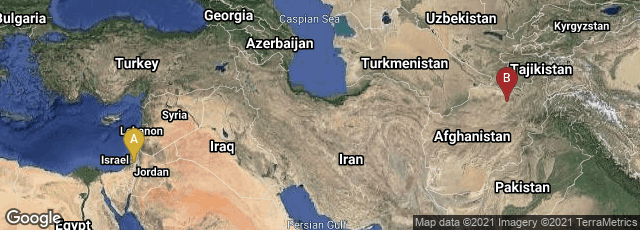
A: Jerusalem, Jerusalem District, Israel, B: Aybak, Samangan, Afghanistan
On January 23, 2012 Reuters reported from Kabul that a cache of ancient Jewish scrolls were discovered in Samangan Province of northern Afghanistan. Written in Hebrew, Aramaic, Judeo-Arabic and Judeo-Persian – the Persian and Afghan Jews' long lost equivalent of Yiddish, which was written in Hebrew letters, the manuscripts are the first physical evidence of a Jewish community in Afghanistan a millenium ago. The thousands of Jewish documents found in caves in Afghanistan were called the Afghan Geniza.
"The 150 or so documents, dated from the 11th century, were found in Afghanistan's Samangan province and most likely smuggled out -- a sorry but common fate for the impoverished and war-torn country's antiquities.
"Israeli emeritus professor Shaul Shaked, who has examined some of the poems, commercial records and judicial agreements that make up the treasure, said while the existence of ancient Afghan Jewry is known, their culture was still a mystery. 'Here, for the first time, we see evidence and we can actually study the writings of this Jewish community. It's very exciting,' Shaked told Reuters by telephone from Israel, where he teaches at the Comparative Religion and Iranian Studies department at the Hebrew University of Jerusalem.
"The hoard is currently being kept by private antique dealers in London, who have been producing a trickle of new documents over the past two years, which is when Shaked believes they were found and pirated out of Afghanistan in a clandestine operation.
"It is likely they belonged to Jewish merchants on the Silk Road running across Central Asia, said T. Michael Law, a British Academy Postdoctoral Fellow at Oxford University's Center for Hebrew and Jewish Studies.
"They might have been left there by merchants travelling along the way, but they could also come from another nearby area and deposited for a reason we do not yet understand,' Law said" (http://www.reuters.com/article/2012/01/23/us-afghanistan-jewish-scrolls-idUSTRE80M18W20120123, accessed 01-03-2013).
In March 2012 it was reported that approximately 200 documents had been found from the Afghan Genizah (Geniza), the most significant find of Hebrew manuscripts since the Cairo Genizah, discovered late in the nineteenth century.
On January 3, 2013 The National Library of Israel in Jerusalem announced that after long negotiations with antiquities dealers it had purchased 29 manuscripts from the Afghan Geniza "out of the hundreds that are said to be available."